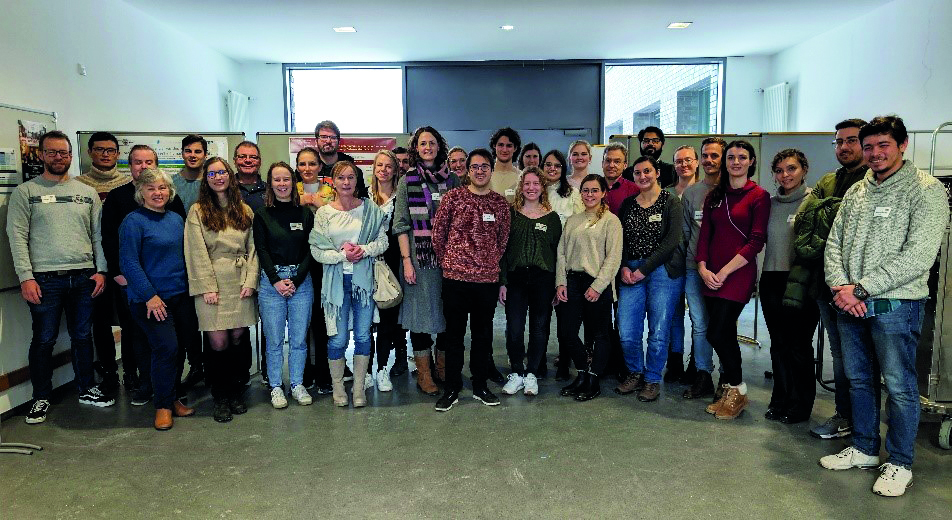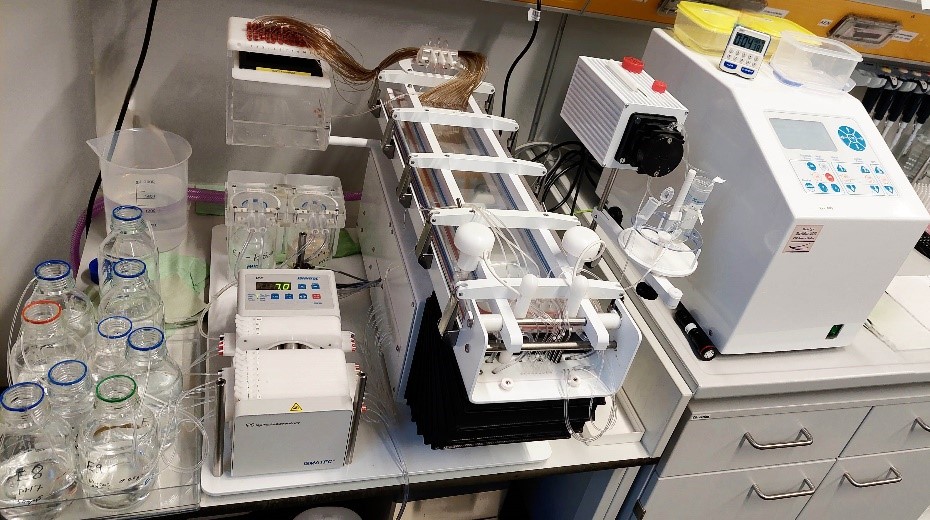The EV Core Facility Marburg
Advancing the frontier of extracellular vesicles research
DOI: https://doi.org/10.47184/tev.2024.01.01As Germany’s first of its kind, the EV Core Facility at Philipps University Marburg pioneers extracellular vesicle (EV) research. With cutting-edge infrastructure and expertise, it advances innovations in EV isolation and characterization, driving breakthroughs in tumor biology, immunology, and diagnostics. Here, we share our journey from the beginning to present.
The pursuit of standardization and rigor plays a pivotal role, especially in the research field of extracellular vesicles (EVs). Although there are meanwhile various attempts to achieve this, such as the MISEV guidelines issued by the ISEV (Welsh et al. 2024) and the establishment of various task force units for more specific issues, the handling and implementation are mostly up to the local researcher. Over the past decade, the various possibilities to isolate and characterize EVs from any biofluid have evolved considerably. Nevertheless, it remains challenging to define a gold standard or to maintain an appropriate overview. There is a steadily emerging interest in EVs and research questions related to them, and many research groups are courageously venturing into the EV field, such as the University Hospital Giessen-Marburg and its research focus on tumor biology and immunology with a strong interest in studying the so-called secretome in the tumor microenvironment.

Figure 1: EV OMICS Workshop in Marburg 2023. A successful collaboration between the EV Core Facility in Marburg and the German Society for Extracellular Vesicles, aimed at discussing the latest technologies in OMICS.
A Vision Realized
Starting from various initiatives, such as a clinical research group focusing on pancreatic cancer (CRU325: “Clinical relevance of tumor-stromal interactions in pancreatic carcinoma“) and the DFG Research Training Group GRK2573: "The inflammatory tumor secretome - from understanding to novel therapies" initiated in 2020 and now supported for a further funding period from 2025 on, the initial idea was to consolidate the existing EV expertise and bring it together in a Core Facility. Core Facilities provide specialized infrastructure and expertise to support and promote research. These facilities' strengths can be found in the efficient use of resources and fostering interdisciplinary collaboration through access to state-of-the-art equipment and expert knowledge. At the time of 2020, the number of Core Facilities specifically designed for EVs worldwide was fairly limited: for example, there was only one Core Facility managed by Pia Siljander in Helsinki, Finland, in Europe at the time, while there was none in Germany. Leveraging many years of EV experience and an already partially existing infrastructure, the first EV facility was founded in Marburg at the beginning of 2020. Even in the heat of the pandemic, much start-up work was initially required to establish certain protocols and methods. One of the pillars of this process at the beginning was one of the first nano-flow cytometer devices - which offers decisive advantages in the characterization of EVs, including high sensitivity and precision in the analysis of size, concentration, and surface markers of EVs at the single-particle level. This allows for detailed and accurate characterization, which is crucial for understanding biological functions and potential therapeutic applications of EVs. Extensive validation work was required to establish nano-flow cytometry, including the development and standardization of protocols, calibration of equipment, and training to ensure reliable and reproducible results. In addition, established methods such as nanoparticle tracking analysis were also used for comparison.
While the start seemed challenging due to the global pandemic, there was immediate interest in the Core Facility and it continued to flourish. In the last two years, a large number of established methods for EV isolation have been offered, such as tangential-flow filtration (TFF), density gradient centrifugation (DG), and size-exclusion chromatography (SEC). These methods were not only offered from the outset, but the underlying principles were also taught, trained, and shared with users. This is illustrated, for example, by the simple production of sepharose-based SEC columns together with the respective users as well as two-day training courses on EV characterization within the GRK. A highlight event was the two-day workshop on EV-Omics organized by the GSEV in cooperation with the Core Facility, where numerous outstanding speakers contributed to the respective OMICS technologies.
Innovative Techniques
The aim of a Core Facility, however, should not only be to establish and maintain the methods but also to explicitly develop and implement new and customized approaches. In this context, we can particularly emphasize our free-flow electrophoresis, a method that was developed in the 1970s, but has only been effectively developed in cooperation with the inventor company for the separation of EVs within the last two years. Free-flow electrophoresis (FFE) is a method of separating particles in liquids by applying an electric field, which causes different particles to be deflected to different degrees based on their charge and mass. This technique has been effectively used to isolate EVs from biofluids that contain important biomarkers for various diseases. Our recent findings, published in the Journal of Extracellular Biology (Preußer et al. 2022), demonstrate the significant potential of FFE in EV research. In our study, we showcased how FFE could be optimized to achieve high-purity EV isolations, which are crucial for subsequent analyses. By fine-tuning the parameters and integrating advanced detection systems in collaboration with other groups, we were able to separate EVs with unprecedented precision. This not only enhances the reliability of EV-based biomarkers but also opens new avenues for understanding the complex role of EVs in disease processes. Clinically, FFE-based EV isolation offers valuable opportunities for early diagnosis, prognosis, and therapy monitoring of diseases as well as for the development of personalized therapies. Here it was also important to strengthen the interest and potential among potential users, especially in the clinic.

Figure 2: Seperation of EVs from primary biofluids using Free-Flow Electrophoresis.
Especially, the collaboration with clinical groups facilitates the comprehensive diagnostic evaluation of EVs
Collaborative Spirit
The networking with various companies that operate in the EV field and especially the close collaborative work within the various Core Facilities on the campus have played a crucial role in creating the shape of the EV Core Facility. Particularly noteworthy is the cooperation with the also newly founded Core Facility Translational Proteomics. Through this alliance, extensive development and establishment work was carried out to ensure targeted mass spectrometric proteome analysis of EVs under one roof. This networking facilitates the transfer of knowledge and technology as well as the joint use of resources and contributes to the further development of efficient methods. This quickly led to successful integration into the research landscape, firstly locally, but also through the opportunity to represent the EV Core Facility at numerous conferences and through cooperation and resulting publications at an international level. The visible recognition is reflected in invitations to renowned conferences such as the 3rd International Symposium on Microgenomics in Florence, Italy (2023), the 44th SEBBM Congress with a symposium on the "Role of EVs in Cellular Communication" in Málaga, Spain (2022), and a presentation on the EV Core Facility in Marburg with a focus on findings from challenging samples (Annual Meeting GSEV 2021 Freiburg, Germany). In addition, active contributions were made to the international scientific community through participation in the EV Club's WebEV Talk series (2021). Overall, this illustrates the contribution of the EV Core Facility to the advancement of knowledge in the field and the dissemination of its findings to a wider scientific audience.
In addition to conventional academic dissemination, we have strategically employed social media platforms such as X and LinkedIn to expand our outreach. Through these channels, we regularly promote our latest research findings, announce upcoming events, and provide insights into the facility's operations. This digital presence has increased our visibility and facilitated engagement with a broader community of EV researchers.
Looking Ahead
As we reflect on our journey, we remain fully dedicated to EV research. The coming years promise exciting developments as we continue to push the boundaries of what is possible. Our facility is more than a workplace; it is a hub of innovation and passion where we can do what we are truly excited about: EVs!


